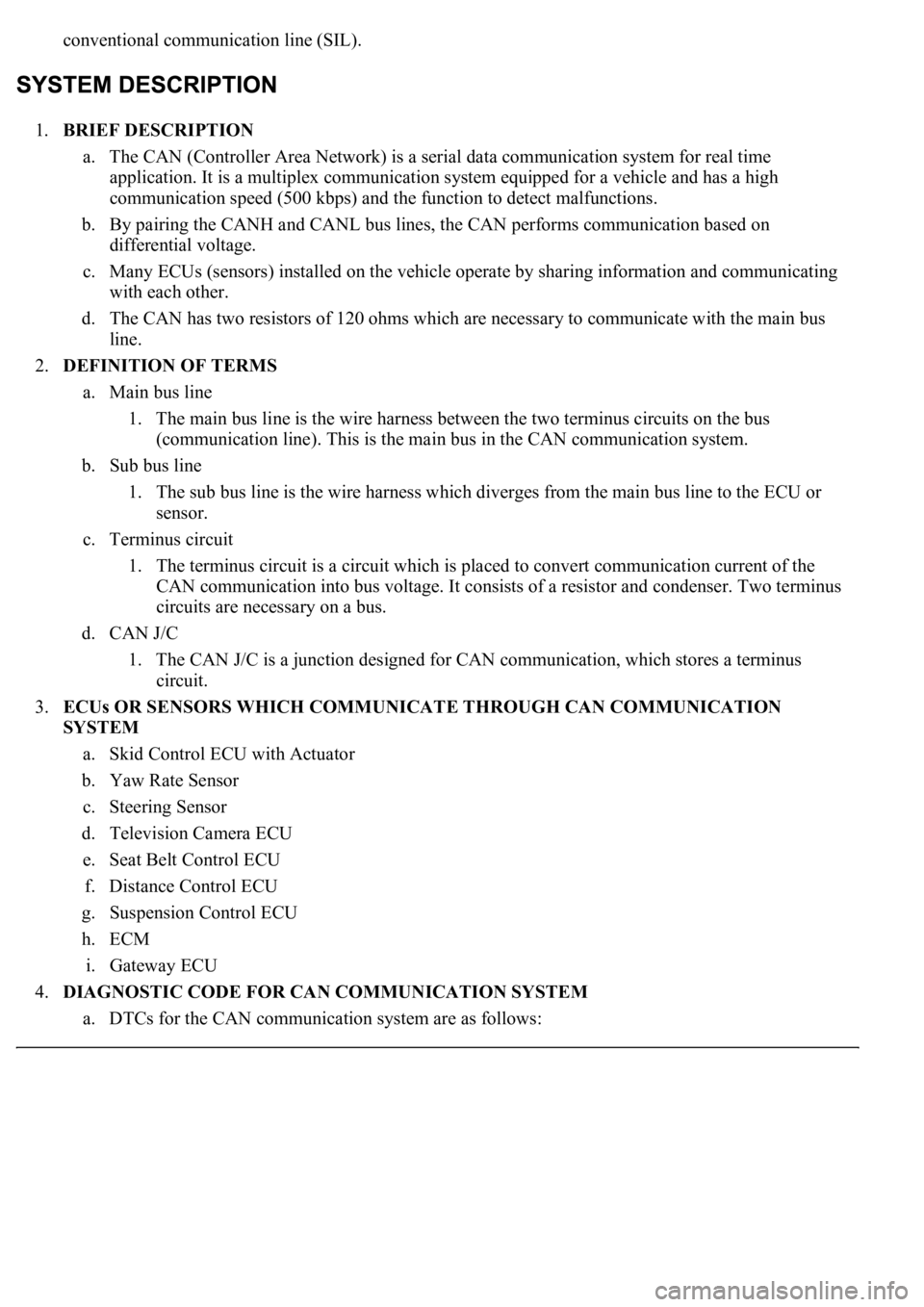Page 1082 of 4500
b. Tighten bolt A.
Torque: 19 N.m (195 kgf.cm, 14 ft.lbf)
c. Tighten nut C, then B.
Torque: Nut B, C 19 N.m (195 kgf.cm, 14 ft.lbf)
d. Connect the ABS & TRACTION actuator assy connector.
Fig. 113: Installing ABS & TRACTION Actuator Assy On Actuator Bracket Assy With Nuts
Courtesy of TOYOTA MOTOR SALES, U.S.A., INC.
e. Using SST, connect the 6 brake tubes to the ABS & TRACTION actuator assy.
SST 09751-36011
Torque: 15 N.m (155 kgf.cm, 11 ft.lbf)
Page 1083 of 4500
Fig. 114: Connecting Brake Tubes To ABS & TRACTION Actuator Assy
Courtesy of TOYOTA MOTOR SALES, U.S.A., INC.
10.FILL RESERVOIR WITH BRAKE FLUID (SEE BLEEDING
)
11.BLEED MASTER CYLINDER (SEE BLEEDING
)
12.BLEED BRAKE LINE (SEE BLEEDING
)
13.CHECK FLUID LEVEL IN RESERVOIR (SEE BLEEDING
)
a. Check the fluid level and add fluid, if necessary.
Fluid: SAE J1703 or JMVSS No. 116 DOT 3
14.CHECK BRAKE FLUID LEAKAGE
If fluid leaks, tighten or replace the leaking part.
15.CHECK ABS & TRACTION ACTUATOR WITH HAND HELD TESTER (SEE DIAGNOSIS
SYSTEM )
16.CLEAR DTC (SEE DIAGNOSIS SYSTEM
)
17.INSTALL FRONT FENDER LINER
a. Install the front fender liner LH, front fender splash shield and front fender outside mouldin
g.
Page 1198 of 4500
Fig. 8: Wiring Diagram - Can Communication System (W/O LEXUS Navigation System)
Courtesy of TOYOTA MOTOR SALES, U.S.A., INC.
HINT:
The position of the terminus circuit differs in vehicles with and without the LEXUS navigation system.
The skid control ECU with actuator detects and stores steering sensor and yaw rate sensor DTCs and
performs DTC communication by receiving information from the steering sensor and yaw rate sensor.
The ECM detects and stores distance control ECU DTCs, and performs DTC communication by
receiving information from the distance control ECU.
The ECM uses the CAN communication system to perform DTC communication instead of the
Page 1199 of 4500

conventional communication line (SIL).
1.BRIEF DESCRIPTION
a. The CAN (Controller Area Network) is a serial data communication system for real time
application. It is a multiplex communication system equipped for a vehicle and has a high
communication speed (500 kbps) and the function to detect malfunctions.
b. By pairing the CANH and CANL bus lines, the CAN performs communication based on
differential voltage.
c. Many ECUs (sensors) installed on the vehicle operate by sharing information and communicating
with each other.
d. The CAN has two resistors of 120 ohms which are necessary to communicate with the main bus
line.
2.DEFINITION OF TERMS
a. Main bus line
1. The main bus line is the wire harness between the two terminus circuits on the bus
(communication line). This is the main bus in the CAN communication system.
b. Sub bus line
1. The sub bus line is the wire harness which diverges from the main bus line to the ECU or
sensor.
c. Terminus circuit
1. The terminus circuit is a circuit which is placed to convert communication current of the
CAN communication into bus voltage. It consists of a resistor and condenser. Two terminus
circuits are necessary on a bus.
d. CAN J/C
1. The CAN J/C is a junction designed for CAN communication, which stores a terminus
circuit.
3.ECUs OR SENSORS WHICH COMMUNICATE THROUGH CAN COMMUNICATION
SYSTEM
a. Skid Control ECU with Actuator
b. Yaw Rate Sensor
c. Steering Sensor
d. Television Camera ECU
e. Seat Belt Control ECU
f. Distance Control ECU
g. Suspension Control ECU
h. ECM
i. Gateway ECU
4.DIAGNOSTIC CODE FOR CAN COMMUNICATION SYSTEM
a. DTCs for the CAN communication system are as follows:
Page 1244 of 4500
Fig. 39: Identifying Skid Control ECU Connectors
Courtesy of TOYOTA MOTOR SALES, U.S.A., INC.
a. Measure the resistance according to the value (s) in the table below.
b. Measure the voltage according to the value (s) in the table below.
Standard:
SKID CONTROL ECU CONNECTOR TERMINALS VOLTAGE
NG: REPAIR OR REPLACE WIRE HARNESS OR CONNECTOR
OK: REPLACE SKID CONTROL ECU WITH ACTUATOR (SEE REPLACEMENT
)
Tester ConnectionConditionSpecified value
S42-1 (GND2) - Body groundAlwaysBelow 1
S42-32 (GND1) - Body groundAlwaysBelow 1
S42-46 (IG1) - Body groundIgnition Switch ON10 to 14 V
Page 1303 of 4500
10.CONNECT CONNECTOR
a. Reconnect the ECM sub bus line connector (J40) to the D-CAN J/C B side (w/o earth terminal).
11.CHECK CAN BUS LINES FOR SHORT CIRCUIT (SKID CONTROL ECU WITH ACTUATOR
SUB BUS LINE)
Fig. 96: Disconnecting Skid Control ECU Sub Bus Line Connector (J41) From D
-CAN J/C (W/O
Earth Terminal)
Courtesy of TOYOTA MOTOR SALES, U.S.A., INC.
a. Disconnect the skid control ECU sub bus line connector (J41) from the D-CAN J/C (w/o earth
terminal).
Page 1313 of 4500
Fig. 105: Identifying DLC3 Connector terminals
Courtesy of TOYOTA MOTOR SALES, U.S.A., INC.
a. Disconnect the skid control ECU connector (S42).
b. Measure the resistance according to the value (s) in the table below.
Standard:
DLC3 CONNECTOR TERMINALS RESISTANCE
OK: REPLACE SKID CONTROL ECU WITH (SEE REPLACEMENT
) ACTUATOR
NG: REPAIR OR REPLACE SKID CONTROL ECU SUB BUS LINE OR CONNECTOR (CAN-
H, CAN-L)
24.CONNECT CONNECTOR
Tester connectionConditionSpecified value
D1-6 (CANH) -D1-14 (CANL)Ignition Switch OFF54 to 69 ohms
Page 1354 of 4500
OK: REPLACE SKID CONTROL ECU WITH ACTUATOR (SEE REPLACEMENT )
NG: REPAIR OR REPLACE SKID CONTROL ECU SUB BUS LINE OR CONNECTOR (CAN-
H, CAN-L)
24.CONNECT CONNECTOR
a. Reconnect the steering sensor sub bus line connector (J43) to the D-CAN J/C B side (w/o earth
terminal).
25.CHECK CAN BUS LINES FOR SHORT CIRCUIT (STEERING SENSOR SUB BUS LINE)
Fig. 145: Identifying DLC3 Connector terminals
Courtesy of TOYOTA MOTOR SALES, U.S.A., INC.
a. Disconnect the steering sensor connector (S16).
b. Measure the resistance according to the value (s) in the table below.
Standard:
D1-6 (CANH) - D1-14 (CANL)Ignition Switch OFF54 to 69 ohms